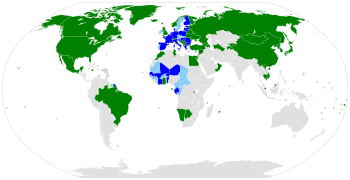Hague Agreement Concerning the International Deposit of Industrial Designs

Hague Union State, Party to 1934 London Act
Hague Union State, Party to 1960 Hague Act
Hague Union State, Parties to 1999 Geneva Act
covered by Regional Economic Integration Organization (REIO), not separate member
Hague Union State, also covered by REIO
|
|
| Signed | 6 November 1925 (The Hague Agreement) 2 June 1934 (London act) 14 July 1967 (The Hague Act/Stockholm addnl Act) 2 July 1999 (Geneva Act) |
|---|---|
| Location | The Hague |
| Effective | 1 June 1928 |
| Parties | 66 |
| Depositary | Switzerland (1925/1934) Netherlands (1960) WIPO |
The Hague Agreement Concerning the International Deposit of Industrial Designs, also known as the Hague system provides a mechanism for registering an industrial design in several countries by means of a single application, filed in one language, with one set of fees. The system is administered by WIPO.
The Hague Agreement consists of several separate treaties, the most important of which are: the Hague Agreement of 1925, the London Act of 2 June 1934, the Hague Act of 28 November 1960 (amended by the Stockholm Act), and the Geneva Act of 2 July 1999.
The original version of the Agreement (the 1925 Hague version) is no longer applied, since all states parties signed up to subsequent instruments. The 1934 London Act formally still applies between a London act state that did not sign up to the Hague and/or Geneva Act in relation with other London act states (Suriname and Benin in relation to the other London states). Since 1 January 2010, however, the application of this act is frozen and it will formally cease to be in force by October 2016 following notifications of all contracting parties.
Countries can become a party to the 1960 (Hague) Act, the 1999 (Geneva) Act, or both. If a country signs up to only one Act, then applicants from that country can only use the Hague system to obtain protection for their designs in other countries which are signed up to the same Act. For instance, because the European Union has only signed up to the 1999 (Geneva) Act, applicants which qualify to use the Hague system because their domicile is in the European Union can only get protection in countries which have also signed up to the 1999 Act or to both the 1999 and 1960 Acts.
All contracting parties to one or more of the instruments of the Hague Agreement are members of the Hague Union. A list is shown below:
A list of the Contracting Parties is maintained by WIPO.
Applicants can qualify to use the Hague system on the basis of any of the following criteria:
An applicant who does not qualify under one of these headings cannot use the Hague system. The Contracting Parties include not only individual countries, but also intergovernmental organisations such as the African Intellectual Property Organization (OAPI) and the European Union. This means an applicant domiciled in an EU member country that is not a Contracting Party, such as Austria or the United Kingdom, can nevertheless use the Hague system on the basis of his or her domicile in the European Union.
...
Wikipedia
